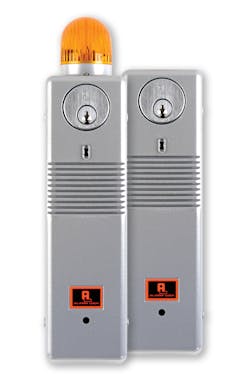Retail lockshops, like most sales and installation organizations, need to diversify and augment their present line of products and services with a number of verticals in the realm of door hardware. Most of us, unfortunately, have our eyes set on the big-ticket items that our clients want and need. We often forget the smaller door accessories that our clients usually go to Lowes or Home Depot to buy. Why not offer these same accessories during the bidding process? Possible accessories to consider include door stops, closers, kick plates and others.
For example, if you specialize on serving retail stores in your locale, you probably provide mortise cylinder locks and exit hardware. Perhaps you also provide in-floor and regular floor safes. All this is good, but what about the smaller accessories that usually follow the installation of a quality door? Do you have any idea how much money you’re leaving on the table?
Door Holders Offer Additional Profits
A good example of this is the sale of mechanical and electric “door holders.” The mechanical type, like the models 29-4-WC (4-inch), 29-6-WC (6-inch), and 29-10-WC (10-inch), manufactured by Moore Industrial Hardware of Cincinnati, OH, are simple to install and even easier to sell to clients. You know they’re going to need them, and that means they’re going to buy them from someone—why not you?
According to Moore, “Shank and escutcheon are made of zinc finish, fine-quality steel. Chromium finish available. The Nylon Copolymer socket insert is practically impervious to wear. It will also withstand extreme temperature ranges. An exclusive Hansen feature is the ability to vary holding power simply by adjusting the socket mounting screw. Adjustable socket increases holding capacity by tightening mounting screw. Available with various degree bends” (Source: http://bit.ly/2bxvL1P) .
Electrified door holders also provide double duty by serving as a door closer and a holder. The model 5800 ADAEZ PRO made by Norton Door Controls, for example, serves both tasks using a single unit.
“The 5800 Series ADAEZ PRO is a compact electromechanical door operator that is simple to install and use. This heavy-duty, low energy operator is ideal for retail outlets, banks, schools or universities, casinos and hospitals. Available for push or pull side mounting, this robust, non-handed operator ships standard with integral RF receiver and two wireless pushbuttons” (Source: http://bit.ly/2b9JxXc).
Door Stops and Kick Plates
Another two pieces of door hardware that you can add to your door accessory list includes the “door stop” and “kick plates.”
ABH Manufacturing Inc. of Itasca, Il., offers a double-lipped strike and rescue stop, both engineered as a stop for double-acting doors. These models also allow a door to swing in the opposite direction where there’s an emergency. The rescue stop is spring loaded with built-in hold back; field convertible; non-handed units. ABH also offers Bio-Guard Antimicrobial Coating, where and when needed.
Kick plates also are a great way to expand your door accessory offerings. According to CD Direct Hardware, “Kick plates are available as a screw mount or magnetic mount options and available in various sizes. Magnetic mount kick plates will not work on wood doors” (see http://bit.ly/2aXsC6B).
Remember, these things may be small as they bring less profit per unit than other products that you may sell and install, but when you consider the number of doors that your techs work on in a new facility, especially when you add up all of the accessories you might sell over the course of a year’s time, then the profit potential should be apparent. There’s also the retrofit market where these accessories eventually ware out or lose their bright finishes and attractiveness over years of use. Advertise these accessories in your monthly newsletters.
Door Annunciators and Viewers
Annunciators in this instance refers to simple mechanical or electronic devices that mount on a common door that makes a sound when someone enters. For example, the PG21MSS Door Alarm, manufactured by Alarm Lock of Amityville, NY, provides a keyed means of entering a door without sounding an alarm while providing protection against break-ins.
The PG21MSS Door Alarm is self-contained with dual-tampers for supervision. It has been newly designed so you can use it on nearly any door you encounter. The alarm unit has an “Always Armed” mode or it can be used in “Standard Arming” mode. Users can easily see what state of operation that the lock is in via an easy-to-see status indicator (red when armed). The Entry Delay Time can be set for 15 sec., 1 min. 15 sec., or 3 min. 15 sec. For more information, on the model PG21MSS, go to: http://bit.ly/2btJBD6.
The next item that Locksmiths should consider offering to their clients provides a means of viewing callers at the door. As a security professional, it’s your duty to provide more than locks. Advise your clients to never open a door without knowing who’s on the other side. Two-piece, through-the-door viewers are commonly installed by drilling a hole at a specified diameter at common eye level and then inserting the two parts into each side of the door, screwing them together until they are tight.
For example, the Peek-O through-the-door viewer, manufactured by Home Protector Manufacturing of Whittier, CA, is manufactured in all standard finishes and they’re approved by the Board of Standards and Appeals for use in New York City. The Peek-O viewer is designed for doors 1 to 2 inches in thickness. They provide a 140 degree field of view while providing an additional 40 degree view to see if someone is in hiding. Best of all, the Peek-O viewer is trendy and suitable for use on high-priced doors. For more information, go to: http://bit.ly/2bTbDsd.
Window Film
The windows in doors, no matter what the size, are a definite liability from a security standpoint. Without a doubt, breaking a door window to gain access to the open and accessible deadbolt and knob-and-key is more common than you might think. One way to slow or stop a thief is to place a protective film over the door glass windows.
ShatterGARD, based in Atlanta, GA, markets and installs a series of window films designed to prevent someone from shattering a door window to gain access. According to ShatterGARD, “Our unique maintenance-free and highly scratch-resistant products improve the structural integrity of any window. In the unlikely event the window breaks, our film will help hold the broken shards together thus reducing the likelihood of window penetration and razor sharp flying glass.”
In most cases these films are largely undetectable by a criminal, especially after dark. The use of window film reduces the need for bars or hurricane shutters. “And, unlike costly ballistic glass, ShatterGARD ™ products are guaranteed not to yellow or distort overtime,” says ShatterGARD. For more information on how you can acquire your own ShatterGARD dealership, go to: http://bit.ly/2b6qZcY.
Door Closers
Last but not least is the door closer. Door closers come in many shapes, sizes, and mounting methods. Door closers have been around for more than a century. Although you would think that locksmiths and these practical devices should go together like soup and a sandwich, this is not always the case.
There are only two screw settings on most commercial closers, one for sweep and the other for drop, as it's all about timing. After you do a few closers, you won't have any problem programming them again.
There are four basic kinds of door closers in use--surface, concealed frame, concealed door, and floor. Today, the predominate type of door closer is surface mounted.
For example, the TS93 System in Contur, manufactured by DORMA of Reamstown, PA, has two separate temperature compensating, non-critical speed adjustments that control sweep and latch (drop). For more information on the TS93, go to: http://bit.ly/2be3cUr. For general information on surface-type closers, go to: http://bit.ly/2bvqXdO.






